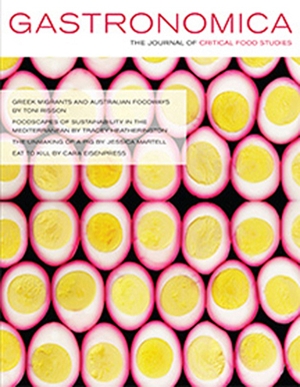Thought for Food: Gastronomica Lives at UCSC
 by Omar Lopez, Class of 2014
by Omar Lopez, Class of 2014
During my first quarter as an Anthropology transfer student, I took Ethnography of Russia with Professor Melissa (Lissa) Caldwell. Although the class material was fascinating (mostly because I had no prior knowledge about Russia), the most memorable moment of the class was when I walked into Lissa’s office hours for the first time. It was actually my first time ever for any class. I immediately confessed to her that I did not have the slightest clue as to what was expected of me in her class and during office hours. She smiled, told me to take a seat, and helped guide me to understand her role as my professor. We talked about her work and her research interests as well as my intellectual background and reasons for majoring in anthropology. Our conversation that day eased my nerves about my ability to talk and build a relationship with professors. Lissa’s welcoming attitude and presence allowed me to feel comfortable with my decision to take her class and to continue talking to her. I am sure that my time as an undergraduate would not have been the same if not for this experience.
Her class had an immediate and profound impact in my intellectual interests. At the time, I didn’t know which area of anthropology I wanted to study the most. However, after taking her class, I was sure I wanted to focus on the cultural track. This prompted me to take another class with her: the Anthropology of Food. Taking this course, I acquired a passion for studying food as a site for culture and cultural practice. It was in this class that I also learned of her position as the editor-in-chief of Gastronomica: The Journal of Critical Food Studies.
This year, at the end of the Fall quarter, I asked Lissa if there were any opportunities available for an undergraduate such as myself to research or intern for Gastronomica. Without hesitation, she told me I could research new and interesting projects about food and culture being done by professors and graduate students. I spent the last few weeks and the entire winter break searching through a large catalog of food studies and related programs to find new ways to think about and with food. The following quarter, I presented to her a list of department websites and emails of graduate students and faculty with descriptions of the kinds of food related projects they were working on. She was surprised and pointed out to me that one of the websites I found was a page that was lost to her from previous years.
This was really important to me because I felt that I could accomplish more than what was expected of me as an undergraduate. With her help, I gained the skills needed to research and investigate projects that are relevant to the journal’s mission and the ability to collect and present the information in a timely manner. Her positive feedback instilled in me a confidence that I rarely experienced. Shortly thereafter, I asked her if I could continue working for Gastronomica for school credit, to which she agreed.
Lissa assigned me a second project. Initially, I intended to collect information on rising trends in technology related to food. More specifically, she wanted me to research a mobile app called Traceable Meat. At first, I only collected articles,blog journals, and videos about Traceable Meat. I soon realized that the social implications that come with a digital information app, like Traceable Meat, had to be written as an analytic paper, not just a basic report. I wasn’t just satisfied with Traceable Meat, however. That’s when I started to research other new food technologies. I soon found out about 3D food printing! The articles that I read and the videos that I watched convinced me that it had to be included in my analysis.
When I first presented my initial write up to Lissa she expressed joy in reading it and requested to consider publishing it in Gastronomica. I was shocked, but immediately agreed to her request. Despite her praise, she also pointed out to me that I would have to edit it in order to reach the intended audience of the journal. I had to learn how to write for a reader that did not have a background in anthropology. I thought to myself that I wouldn’t be able to write to a non-anthropology audience, especially because I’ve been trained to write anthropologically from the moment I started taking classes, beginning with her class. Lissa took this into consideration and told me that she would ask Rebecca Feinberg, an anthropology PhD student, to help me write in a more accessible manner.
Rebecca really made a difference because she spent a considerable amount of time reading my paper and commenting on it. She also met with me to go over her comments and gave me suggestions on ways to write and present information without using too much jargon. This was extremely helpful because I was able to make the transition to write for different audiences, which is an important skill to have.
Thanks to Rebecca and Lissa, I finished editing my paper in time to submit it for review. A quarter’s worth of research, writing, editing, and signing paperwork culminated in a long wait to see my brief in the journal. I told some of my friends about my accomplishment as a published writer. I was met with excitement and an overwhelming amount of congratulatory remarks. Now, as a graduated student, I look back to this experience as an important piece to my diploma. I couldn’t have done it without all of the people I got to work with over these past two years. I especially wouldn’t have been able to if I didn’t have that initial conversation with Lissa.
